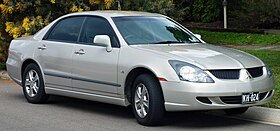Mitsubishi Magna
| Mitsubishi Magna | |
|---|---|
 |
|
| Overview | |
| Manufacturer | Mitsubishi Motors Australia |
| Production | 1985–2005 |
| Body and chassis | |
| Class | Mid-size car |
| Chronology | |
| Predecessor | Mitsubishi Sigma |
| Successor | Mitsubishi 380 |
| First generation | |
|---|---|

Magna Elite sedan (TP)
|
|
| Overview | |
| Production | April 1985 – March 1991 (sedan) June 1987 – May 1992 (wagon) |
| Body and chassis | |
| Body style | 4-door sedan 5-door station wagon |
| Related | Mitsubishi Galant (fifth generation) |
| Powertrain | |
| Engine | 2.6-litre Astron II (4G54) I4 |
| Transmission | 4-speed ELC automatic 5-speed manual |
| Dimensions | |
| Wheelbase | 2,600 mm (100 in) |
| Length | 4,600 mm (180 in) (1985–86) 4,620 mm (182 in) (1987–91) 4,723 mm (185.9 in) (wagon) |
| Width | 1,760 mm (69 in) (1985–86) 1,765 mm (69.5 in) (1987–91) |
| Height | 1,400 mm (55 in) (1985–86) 1,396 mm (55.0 in) (1987–91) 1,486 mm (58.5 in) (wagon) |
| Curb weight | 1,193–1,265 kg (2,630–2,789 lb) (1985–86) 1,211–1,321 kg (2,670–2,912 lb) (1987–91) 1,247–1,420 kg (2,749–3,131 lb) (wagon) |
| Second generation (TR, TS) | |
|---|---|

Magna Executive sedan (TR)
|
|
| Overview | |
| Also called |
Mitsubishi Diamante Mitsubishi Sigma (Europe) Mitsubishi Verada Mitsubishi V3000 (New Zealand) |
| Production | April 1991 – March 1996 (sedan) May 1992 – March 1997 (wagon) |
| Body and chassis | |
| Body style | 4-door sedan 5-door station wagon |
| Related | Mitsubishi Diamante (first generation) |
| Powertrain | |
| Engine | 2.6-litre Astron II (4G54) I4 3.0-litre Cyclone (6G72) V6 |
| Transmission | 4-speed INVECS automatic 5-speed manual |
| Dimensions | |
| Wheelbase | 2,722 mm (107.2 in) |
| Length | 4,746 mm (186.9 in) |
| Width | 1,775 mm (69.9 in) |
| Height | 1,430 mm (56.3 in) |
| Curb weight | 1,356 kg (2,989 lb) |
| Third generation | |
|---|---|

Magna sedan (TE)
|
|
| Overview | |
| Also called |
Mitsubishi Diamante Mitsubishi Verada |
| Production | April 1996 – September 2005 (sedan) March 1997 – September 2005 (wagon) |
| Body and chassis | |
| Body style | 4-door sedan 5-door station wagon |
| Related | Mitsubishi Diamante (second generation) |
| Powertrain | |
| Engine | 2.4-litre Sirius (4G64) I4 3.0-litre Cyclone (6G72) V6 3.5-litre Cyclone (6G74) V6 |
| Transmission | 4-speed INVECS II automatic 4-speed Sports Mode automatic 5-speed Sports Mode automatic 5-speed manual |
| Dimensions | |
| Wheelbase | 2,722 mm (107.2 in) |
| Length | 4,746 mm (186.9 in) |
| Width | 1,775 mm (69.9 in) |
| Height | 1,430 mm (56.3 in) |
| Curb weight | 1,372 kg (3,025 lb) |
The Mitsubishi Magna is a mid-size car that was produced over three generations between 1985 and 2005 by Mitsubishi Motors Australia Limited (MMAL). Developed as a replacement for the Mitsubishi Sigma, each Magna generation derived from Japanese platforms re-engineered for the Australian market and conditions. Initially, Magna offered inline-four engines in a mid-size sedan package—a station wagon debuted in 1987. Over the years, each new series grew in size, and with the second generation of 1991, the range was bolstered by a luxury variant called Mitsubishi Verada and a V6 engine. During this time, the Magna/Verada became the first Australian-made vehicle to be exported worldwide in large numbers, predominantly as the Mitsubishi Diamante. The third and final iteration Magna/Verada launched in 1996, adding all-wheel-drive (AWD) from 2002, and receiving a substantial styling update in 2003. They were replaced by the Mitsubishi 380 in 2005.
MMAL manufactured the Magna/Verada at its Clovelly Park, South Australia plant. The majority of its engines—most notably, the original four-cylinder Astron II (codenamed 4G54) and subsequent Cyclone V6 engines (codenamed 6G72 and 6G74)—were manufactured at the Lonsdale, South Australia plant.
Following a claimed A$50 million development cost, Mitsubishi introduced the Magna to Australia in April 1985, initially as a sedan only model, but with a station wagon added in June 1987. It was manufactured at Tonsley Park, South Australia. MMAL designated this first Magna as the TM series, with the 1987 and 1989 updates known as the TN and TP series, respectively.
...
Wikipedia
